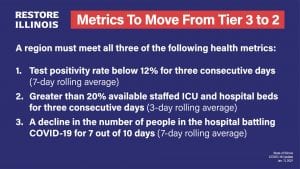What Are The Differences In Illinois’ Tiers And Phases For Covid?
Phases, tiers, mitigations… oh my!
Many have seen a variety of terms used in regard to the precautionary measures put forth by the state of Illinois in its covid-19 protocols, as we all await word on how these mitigations are going to impact our lives as they change over time. As we at QuadCities.com have reported, the Quad-Cities area is scheduled to go from tier 3 to the less restrictive tier 2 on Friday.

JB Pritzker announced that the Quad-Cities’ Region 2 is eligible to move to Tier 2 mitigations starting Friday.
But what does that mean?
Sure, I can say, according to the metrics put forth by Pritzker on Nov. 20, a region can move down to Tier 2 mitigations if it sees a test positivity rate less than 12% for three consecutive days and more than 20% of ICU and hospital beds are available, as well as declining COVID-19 hospitalizations in seven of the previous 10 days.
And, according to numbers released this weekend, the Quad-Cities’ Region 2 saw its positivity rate go up to 9.6 percent, up from 8.9 percent a week earlier, but still below the 12 percent threshold needed. Region 2 saw good numbers in regard to its seven-day rolling average number of COVID-19 patients in the region’s hospitals, going down to 305 on Jan. 7, down from 331 a week earlier and falling on nine of the past 10 days. The Quad-Cities Region hits the trifecta in regard to reduced mitigations due to its rolling average of hospital bed availability, as the three-day rolling average availability was 22.4 percent for surgical beds and 23.8 percent for ICU beds on Jan. 7 — making it 11 consecutive days that both numbers have remained above the 20 percent threshold, also a positive sign.
But what the heck does that all mean, and what do we all get to do once we move to tier 2?
Well, THIS is what we get to do when we move to Tier 2.
ALSO, for more info on the region metrics in Illinois click here.
But what does that mean, what are the phases and tiers and how do they fit in?
We understand it can be confusing, so we’ve provided, through the state of Illinois, these helpful graphics.















Leave a Reply
You must be logged in to post a comment.